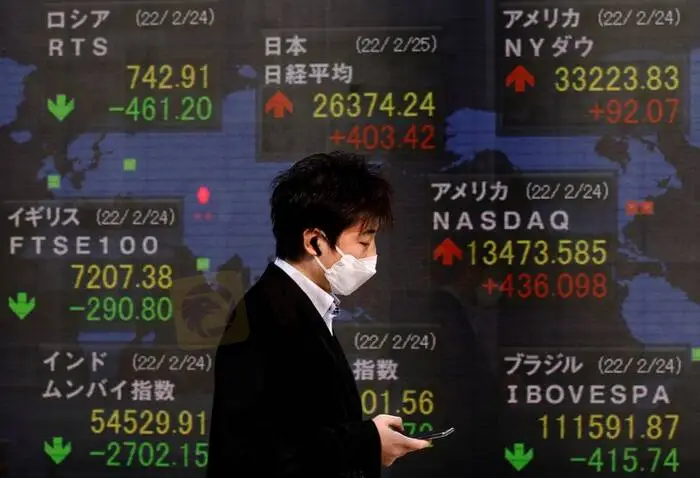简体中文
繁體中文
English
Pусский
日本語
ภาษาไทย
Tiếng Việt
Bahasa Indonesia
Español
हिन्दी
Filippiiniläinen
Français
Deutsch
Português
Türkçe
한국어
العربية
Asia shares fall on China slowdown fears, but lower yields limit losses
Abstract:Mainland China and Hong Kong stocks fell on Thursday, hurt by worries about the Chinese economy, but an overnight tumble in longer dated U.S. treasury yields lent support to other benchmark indexes.
Fears of a sharp economic slowdown in China and higher oil prices weighed on most Asian stocks on Thursday, but a dip in U.S. treasury yields offered some relief for broader markets worried by the prospect of aggressive rate hikes.

Chinese and Hong Kong shares hit month lows and the yuan fell to its lowest in six months as Shanghai authorities said tough COVID-19 restrictions would remain in place.
Chinese blue chips shed 1.8% while Hong Kong stocks fell 2%, both falling to their lowest level since mid March. The spot yuan touched 6.4478 per dollar, its softest level since October.
The declines pulled MSCIs broadest index of Asia-Pacific shares outside Japan 0.66% lower, despite gains in Korea and Australia, where the local benchmark rose 0.4% to not far off a record peak.
Japans Nikkei rose 1.22%.
Analysts at Nomura said they were cutting their Q2 China GDP growth forecast to 1.8% year-on-year from 3.4%, “owing to rapidly worsening high-frequency activity data in April, the rising number of cities under full and partial lockdowns, severe logistics disruptions, and signs that Beijing is unlikely to end its zero-Covid strategy soon.”
A prolonged slowdown in China would have substantial global spillovers, IMF Managing Director Kristalina Georgieva said on Thursday, but added that Beijing has room to adjust policy to provide support.
However, U.S. and European stock futures pointed to higher opens elsewhere. EUROSTOXX 50 futures gained 0.4% and FTSE futures rose 0.3%, while Nasdaq futures jumped 0.8% and S&P500 futures advanced 0.5%.
Part of the reason for the share market gains, said analysts, was the overnight decline in the U.S. benchmark 10-year yield, even if though this might prove short lived.
It was last at 2.8766%, a little higher in Asia trade, but still bruised after falling from as high as 2.981% early on Wednesday.
“I think were still heading towards 3% for 10 year treasuries, I think it was a little bit of profit taking,” said Rob Carnell, head of research for Asia Pacific at ING.
Lower yields sent the dollar lower overnight, particularly against the beaten down euro and sterling which managed to recover a little ground. [FRX]
Moves were more muted in Asia hours. The dollar index was little changed at 100.36, down from a near two-year peak the previous day of 101.03.
The dollar gained 0.22% on the yen to 128.16, however, as the yens recovery on Wednesday – its first session of gains against the dollar in nearly two weeks – proved short-lived.
The yen has quickly slid to 20-year lows, hurt by the Bank of Japan keeping yields pinned down low while rates rise in the United States. Investors believe it has even further to fall, with most betting that even a government intervention wouldnt be enough to turn around the momentum.
Oil prices firmed in choppy trade as concerns about supply due to a potential European Union ban on Russian oil came to the fore. Russian forces stepped up their attacks in eastern Ukraine on Thursday.
Brent crude futures rose 1.54% to $108.44 a barrel, and U.S. crude futures rose 1.44% to $103.7.
Spot gold fell 0.25% to $1,954.7 an ounce.
(Reporting by Alun John; Editing by Edwina Gibbs and Kim Coghill)
Disclaimer:
The views in this article only represent the author's personal views, and do not constitute investment advice on this platform. This platform does not guarantee the accuracy, completeness and timeliness of the information in the article, and will not be liable for any loss caused by the use of or reliance on the information in the article.
WikiFX Broker
Latest News
Ghana Trader Jailed for $300K Forex and Crypto Scam
US Dollar Surge Dominates Forex Market
Hong Kong Police Bust Deepfake Crypto Scam Syndicate Involving $34 Million
Is it a good time to buy Korean Won with the current depreciation?
Pepperstone Sponsored the "Aston Martin Aramco Formula One Team"
BlackRock Bitcoin ETF Outflows Hit $332M in Single Day
XRP Price Prediction for 2025: Will It Hit $4.30 or More?
Exnova Scam Alert: Account Blocked, Funds Stolen, and Zero Accountability
T3 Financial Crime Unit Freezes $100M in USDT
Terra Founder Do Kwon Denies Fraud Allegations in U.S. Court
Currency Calculator







